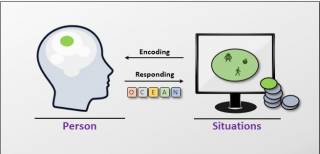 The GADP (Game-Based Assessment of Dynamic Personality) project introduces a novel research method aimed at assessing behaviors within different situations. Moving beyond the traditional focus on stable personality traits, this approach aims to capture individuals’ “personality signatures” characterized by complex if…then contingencies (Mischel & Shoda, 1995). By considering the dynamic parameters of one’s personality (such as distribution of states; Sosnowska et al., 1996), this method offers a deeper understanding of the functional nature of personality and adaptation to changing circumstances.
The GADP (Game-Based Assessment of Dynamic Personality) project introduces a novel research method aimed at assessing behaviors within different situations. Moving beyond the traditional focus on stable personality traits, this approach aims to capture individuals’ “personality signatures” characterized by complex if…then contingencies (Mischel & Shoda, 1995). By considering the dynamic parameters of one’s personality (such as distribution of states; Sosnowska et al., 1996), this method offers a deeper understanding of the functional nature of personality and adaptation to changing circumstances.
The project extends the traditional trait approach to personality by incorporating novel approach. First, we utilize game-like virtual environment that allows full experimental control of situations. This help to sidestep the problem of situation selection present in observational designs (e.g., Ecological Momentary Assessment). Second, in the virtual game-like environment the game character is controlled by using the terminology of the Big Five (B5) personality model. In other words, the game program automatically translates the B5 responses to automatic actions of the game character. If this approach proves to be valid and reliable, it can open new research avenues, allow collection of large data, and can be easily adjusted to various research settings.
The project has developed Game-Based Assessment of Big Five (GAB5), which is available for researchers. You can see how the game works in Demos-section and download it Materials-section.
Pilot data has already been collected (see Materials) and preliminary analyses are underway (see Publications and Presentations).
In this project we apply the new approach to the study of personality, attachment dynamics, and psychopathology (for more information, see Framework). Through the innovative methodology, the project holds the potential to enhance our understanding of personality functions and provide valuable insights into the complex dynamics between individuals and their environments.
